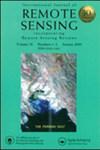A shaped collaborative representation-based detector for hyperspectral anomaly detection
IF 1.5
4区 地球科学
Q3 IMAGING SCIENCE & PHOTOGRAPHIC TECHNOLOGY
引用次数: 0
Abstract
ABSTRACTA modified version of the collaborative representation-based detector (CRD) is proposed for hyperspectral anomaly detection. In contrast to the conventional CRD, which uses a rectangular dual window, the shaped CRD (SCRD) selects the most appropriate neighbours from the dual window and discards the inappropriate ones. To this end, similarity of the neighbouring pixels to the centre is computed based on the cosine distance to utilize the local information. In addition, the low/high occurrence probability of anomalies/background exhibited in the histogram of the whole image is utilized as global information to find the closest neighbours to the background. The shaped dual window is used for linear approximation of pixels through the collaborative representation. SCRD improves the anomaly detection results with respect to some related works. Experiments on two hyperspectral images show that SCRD results in more accurate detection maps with a bit higher running time compared to CRD.KEYWORDS: collaborative representationdual windowhyperspectral imageanomaly detection Disclosure statementNo potential conflict of interest was reported by the author.基于形状协同表示的高光谱异常检测
提出了一种改进的基于协同表示的高光谱异常检测方法(CRD)。与使用矩形双窗口的传统CRD相比,形状CRD (SCRD)从双窗口中选择最合适的邻居,并丢弃不合适的邻居。为此,基于余弦距离计算邻近像素与中心的相似性,以利用局部信息。此外,利用整幅图像直方图中显示的异常/背景的低/高出现概率作为全局信息,寻找与背景最近的邻居。通过协同表示,利用形状双窗口对像素进行线性逼近。SCRD改进了一些相关工作的异常检测结果。在两幅高光谱图像上的实验表明,与CRD相比,SCRD可以获得更精确的检测图,但运行时间略长。关键词:协同表示双窗超光谱图像异常检测披露声明作者未报道潜在利益冲突。
本文章由计算机程序翻译,如有差异,请以英文原文为准。
求助全文
约1分钟内获得全文
求助全文
来源期刊

Remote Sensing Letters
REMOTE SENSING-IMAGING SCIENCE & PHOTOGRAPHIC TECHNOLOGY
CiteScore
4.10
自引率
4.30%
发文量
92
审稿时长
6-12 weeks
期刊介绍:
Remote Sensing Letters is a peer-reviewed international journal committed to the rapid publication of articles advancing the science and technology of remote sensing as well as its applications. The journal originates from a successful section, of the same name, contained in the International Journal of Remote Sensing from 1983 –2009. Articles may address any aspect of remote sensing of relevance to the journal’s readership, including – but not limited to – developments in sensor technology, advances in image processing and Earth-orientated applications, whether terrestrial, oceanic or atmospheric. Articles should make a positive impact on the subject by either contributing new and original information or through provision of theoretical, methodological or commentary material that acts to strengthen the subject.
 求助内容:
求助内容: 应助结果提醒方式:
应助结果提醒方式:


